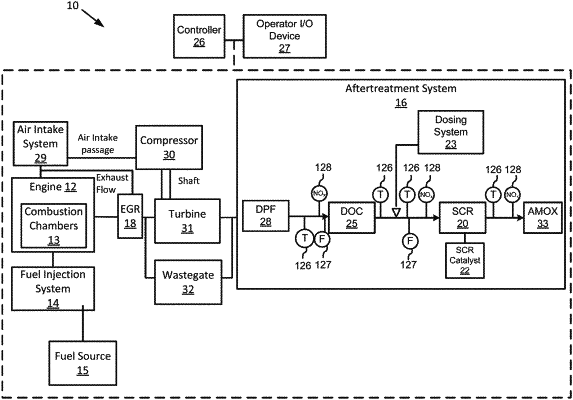| CPC F02D 41/0255 (2013.01) [F02D 41/1461 (2013.01); F02D 41/3836 (2013.01); F02D 41/405 (2013.01); F01N 3/0231 (2013.01); F01N 3/0807 (2013.01); F01N 3/2006 (2013.01); F01N 9/00 (2013.01); F01N 9/005 (2013.01); F01N 11/002 (2013.01); F01N 11/005 (2013.01); F01N 2410/06 (2013.01); F01N 2430/06 (2013.01); F01N 2550/03 (2013.01); F01N 2570/14 (2013.01); F01N 2900/1404 (2013.01); F01N 2900/1602 (2013.01); F01N 2900/1606 (2013.01); F01N 2900/1611 (2013.01); F01N 2900/1614 (2013.01); F01N 2900/1622 (2013.01); F01N 2900/1626 (2013.01); F02D 2200/0802 (2013.01); F02D 2200/0806 (2013.01); F02D 2250/36 (2013.01)] | 17 Claims |

|
1. A method, comprising:
initiating a low engine-out NOx (LEON) mode by controlling a component of a vehicle having an aftertreatment system to decrease an instantaneous engine-out NOx (EONOx) amount;
comparing a temperature of the aftertreatment system during the LEON mode to a warm-operation threshold temperature;
responsive to determining that the temperature of the aftertreatment system exceeds the warm-operation threshold temperature, disengaging the LEON mode;
responsive to determining that the temperature of the aftertreatment system is below the warm-up operation threshold temperature, comparing information indicative of an operating status of the vehicle to a LEON exit threshold, wherein the information indicative of the operation status of the vehicle during the LEON mode comprises an amount of soot build-up on a particulate filter of the aftertreatment system and the LEON exit threshold comprises a soot build-up threshold; and
disengaging the LEON mode responsive to determining that the information indicative of the operating status of the vehicle during the LEON mode exceeds the LEON exit threshold.
|